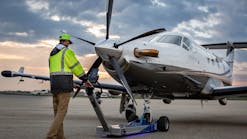Key Considerations for Effective Ramp Communication
To the casual observer, the airside environment at busy airports can seem like a chaotic choreography of aircraft, ground support equipment (GSE) and a variety of support vehicles. For ground support personnel, the ramp is a dangerous place, e.g., that catering truck in the wrong place at the wrong time. Once the command from the flight deck of “brakes released” is given, it is the ground crew that becomes temporarily responsible for the safe maneuvering of aircraft, ensuring that no part of the aircraft structure will impact other aircraft, support vehicle or fixed object.
This is no easy task based on data from the International Air Transport Association (IATA) as reported by the Flight Safety Foundation (FSF) website:
“The Foundation estimates that 27,000 ramp accidents and incidents – one per 1,000 departures – occur worldwide every year. About 243,000 people are injured each year in these accidents and incidents; the injury rate is nine per 1,000 departures.
“Ramp accidents cost major airlines worldwide at least $10 billion a year. These accidents affect airport operations, result in personnel injuries and damage aircraft, facilities and ground support equipment.”
Given these sobering statistics, forward-thinking airlines are constantly looking for new technology to make the ramp environment a safer place, and ground personnel more productive. The aviation website “Skybrary” (as well as numerous FAA studies related to the causes of airside accidents) cites that lack of clarity in communications has been identified either as a leading cause, or the leading cause, of airside accidents and incidents.
Headset Communication Systems on the Ramp
Communication headsets are common in the ramp environment. Wired headset systems are primarily used during aircraft pushback and deicing/anti-icing operations. Traditionally during pushback, the tug operator communicates with the flight deck via a headset and cable connected to the aircraft interphone, or in the case of deicing operations, from the deicing vehicle intercom to the bucket. While wired headsets provide clear communication and hearing protection from the roar of jet engines and other sources of ambient noise on the apron, they have limitations:
- Wired headsets require users to be tethered to the aircraft, limiting the mobility of ground support personnel to move freely around the aircraft.
- Wired headset systems are not designed for multiple users, e.g., wing-walkers, critical to the safe movement of the aircraft, are left out of the communication loop.
- The wires and cables required for wired headset systems can get entangled with other equipment and are subject to damage, wear and the cost of frequent replacement.
Finally, there is the ever-present danger of lightning strikes. Should the aircraft be struck by lightning, the wire or cable connecting the aircraft to the push tug and driver becomes a ready conduit for injury and electrocution. The abstract: Lightning Threats and Enhancements of Safety for Airside Operations (published in May 2017), cites that, “Usage of headsets with connecting wire between the aircraft and the headset worn by the user account for 51.9 percent of lightning related injuries.”
The Advent of Wireless Systems
The introduction of wireless headset systems to the airline industry around 2010 has dramatically improved ground operations, enabling effective communication between the person in charge of the flight deck and the marshalling agent or person in charge of the ground crew, as well as between ground crew members. Because many wireless systems have a range of up to 300 feet (approx. 100 meters), wing-walkers are transformed into “wing-talkers” – no longer having to rely exclusively on hand signals and visual cues to communicate with the tug driver. This is particularly important for any pushback requiring multiple turns and pushing in a tight area, close to airport buildings, GSE and other aircraft. In many of these cases, the tug driver may momentarily lose visual contact with the wing-walker and miss a hand signal. The wing-walker’s ability to verbally communicate directions and warnings to the driver in real time is critical.
Most wireless headset systems accommodate multiple users (up to four with some systems) per wireless gateway or base station. Rather than a single user communicating only with the flight deck as with a wired headset system, there are more eyes and ears working on a pushback deployment, significantly reducing the potential of an accident and subsequent personal injury or damage to aircraft and other ramp equipment.
Additional benefits of wireless systems on the ramp include:
- Hands-free, full-duplex communication – critical for tug and deicing truck drivers/bucket operators to perform their tasks productively and efficiently.
- Improved situational awareness – all crew members are on the same page and aware of any potential dangers during ground support operations.
- Enhanced deicing operations – keeps bucket personnel in constant contact with the deicing driver without delays and stoppages to expedite deicing operations, less waste of valuable deicing fluids.
- Expands ground support applications – beyond pushback and deicing, can be used to facilitate aircraft loading, towing, maintenance and general ramp operations.
- Hearing protection – protects the hearing of ground crew personnel against the roar of jet engines and the din of apron activity and other equipment.
- Contributes to on-time performance - time between flights (beating the gate clock) is of paramount importance to airlines. Every minute saved helps avoid delays, contributes to improved turnaround, bottom line profitability and keeps customers happy.
Wireless System Similarities and Differences
Many wireless systems on the market today share similar characteristics. However there are significant differences worth mentioning. Most wireless headset systems for the airline industry utilize a Digital Enhanced Cordless Telecommunications (DECT) wireless protocol as opposed to Bluetooth wireless. DECT was developed explicitly for wireless audio. Bluetooth frequencies are in the ISM band where industrial and consumer products operate. DECT, however, operates at frequencies reserved exclusively for voice communication using the DECT protocol. Bluetooth wireless is also limited to a range of approximately 50-feet, much too short for most ramp applications.
Wireless Versus Cordless
Another important distinction between wireless headset systems is their configuration. There are marked differences between ‘wireless’ systems and ‘cordless’ systems. Many cordless wireless communication systems feature headsets that contain all electronics within the ear cups of the headset. Although this type of system provides “cordless” freedom and mobility, the self-contained design means that the headsets may be inherently heavier and bulkier. Comfort is an important consideration for any headset, but for airline personnel that work long hours on the ramp, headset comfort is not a luxury, but a necessity.
As with any wireless headset, charging is also an important consideration. Should a self-contained headset require charging, the headset must be taken out of service and replaced by a fully charged headset. Rather than having to purchase additional headsets as backups, many airlines lean toward a wireless system that features a belt station containing the wireless “radio” and is powered by a Li-Polymer battery that provides 24 hours of continuous use. Should power run low, the user can simply replace the battery in the belt station and continue working while the headset remains in service.
Wireless Headsets that “Talk”
Some wireless headset systems also offer a variety of smart feature sets in the form of audio/voice prompts to assist ground personnel. These include link/purge status, out-of-range and low battery parameters. Many wireless systems simply shutdown automatically when users are out of range or if the signal is lost. To provide added safety, some systems provide audio prompts (such as series of ‘beeps’) when the user is approaching the extent of the system’s wireless range. This is followed by a voice prompt that automatically notifies ground crew members if communication connectivity has been lost, allowing them to return within range if possible or react accordingly if not. An additional voice prompt will then indicate when users are within the system's wireless range and connectivity has been restored. The voice prompt feature is crucial to safety in the ramp environment.
Another important characteristic is the system link itself. For a wireless user to be able to communicate within the intended intercom system, they must first establish a link, or digital “handshake,” establishing the authentication of the user to gain permission to enter the system. With some systems, the user must re-link each time the system either powers down or the user moves outside the working range. “Self-healing” systems, however, automatically reconnect upon either of these instances without ever losing the comms link, unless users intentionally purge themselves from the system to delete the link to the system gateway.
System Durability for the Ramp Environment
Lastly, it is critical to be sure that wireless system components are purpose-built to stand up to the rigors of the ramp environment. Not all wireless headsets and system components are created equal. Look for those that offer marine-grade, water-tight, impact resistant enclosures, and a wide temperature operating range. It is also important to remember that wireless headsets are normally shared by ground crew personnel, so hygiene is an important factor. Headsets and components should be easy to clean and maintain. Headset head pads and ear seals should be made using non-porous materials, polyurethane material for easy and effective cleaning and disinfection.
Effective communication between the flight deck and ground crew, and between ground crew members, is critical. There is a growing consensus among airlines that clear voice communication is a welcome enhancement to traditional hand signals and safety protocols. Wireless headset systems improve overall safety, situational awareness and hearing protection for ground crew members - contributing to accident avoidance and on-time airline performance.
Bob Daigle, systems manager at David Clark Company, has more than 15 years of experience working with hundreds of airlines – from small regionals to major carriers worldwide – in the design, configuration and implementation of both wired and wireless headset systems for airside communication applications.






